
TISHREI 5781
HEALTHY & SWEET NEW YEAR ד”סב א”פשת ירשת הקותמו הבוט הנשל
WISHING YOU A HAPPY,
CERTIFIED SOUL NUTRITION
KOSHER
Dear Reader,
The COVID-19 pandemic has spread to every part of the world and nobody was left unaffected. I sincerely hope that you and your loved ones are doing well. At the ~ we have certainly seen and felt the wrath of this pandemic, both on a personal level and on a professional level as a global leader in kosher certification. Knowing how crucial kosher certification is to the kosher consumer, we continue, with Hashem’s help, to make every effort to adapt to the present and, Baruch Hashem, we are successfully living up to the challenge.
I am thankful that, as a global kashrus organization, we recognize the siyata d’shmaya in everything we do. We, Baruch Hashem, have strong leadership and good teamwork, clear protocols, vast experience, and we are blessed with a tremendously devoted staff. The ~ has some of the world’s foremost experts in kosher, who live and breathe kosher and who have made high level kosher supervision their life’s mission. Moreover, at ~ Kosher we are fortunate to have relationships with health experts and local authorities worldwide. Our Rabbonim and leaders are in constant contact with them to make sure that both our kosher procedures and local safety policies are kept in place and not compromised.
After a challenging few months of quarantine, where we made good use of the latest technologies through constant Zoom meetings (with sometimes as many as 300 participants!) and FaceTime discussions, it is so comforting to see our staff physically trickling back in to the office, complete with face masks and social distancing. You can find our lights on until the late hours of the night as dedicated employees come in to attend to their essential work at all hours of the day and night to ensure kosher without compromise.
Of course, our offices will never be the same without Rabbi Levy, OB”M; his mere presence, even the way he walked down the hall greeting each staff member with a smile, is sorely missed by all of us. We are comforted by keeping his legacy alive and continuing to uphold his high kashrus standards. We are going to be reprinting some of his past articles on kosher in the pages of the Kosher Spirit. It’s reassuring to see that, slowly but surely, the kosher standards that Rabbi Levy wanted to see become mainstream are becoming part of the standards of many reputable agencies.
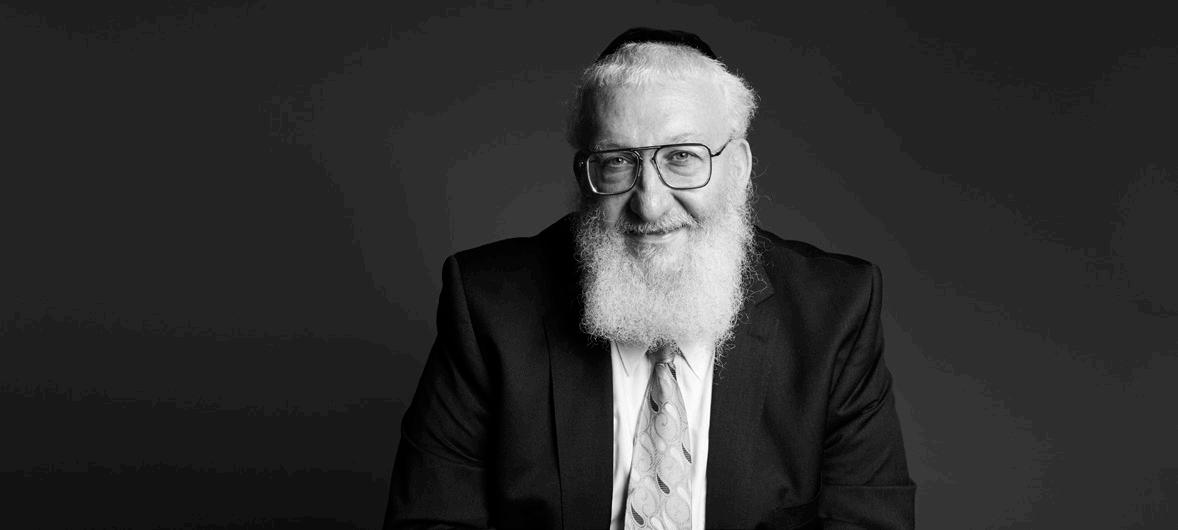
One last note as we get ready for Rosh Hashanah. We must realize and remember that all that happened this past year to us, to our communities, and to the world at large, was decided last year on Rosh Hashanah. May all of our prayers be answered on Rosh Hashanah this year, for long life, good health and the ultimate blessing of the coming of Moshiach speedily in our time.
Wishing you and your family k’siva v’chasima tovah, l’shana tovah u’mesukah. May you be written in the Book of Life for a happy and sweet year.
Rabbi Chaim Fogelman Editor in Chief ~ Kosher Vaad HaKashrus
4 SHARE YOUR SPIRIT 5 HEALTHY SPIRIT 6 RABBI ON THE ROAD with Rabbi Yoni Rappaport 8 TISHREI RECIPE: APPLE BLUEBERRY TURNOVERS by Danielle Renov 9 REMEMBERING RABBI DON YOEL LEVY OB”M Kosher Transport 12 FIRST FRUITS: AN OVERVIEW OF THE LAWS OF ORLAH by Rabbi Sholom Ber Lepkivker 16 REMEMBERING MRS. THELMA LEVY 18 A CLOSER LOOK: WHAT IS BITUL? By Rabbi Sholom Ber Hendel 20 WHO’S BEHIND THE ~ Interview with Mr. Eli Methal 21 YOUR KOSHER KITCHEN: FRYING PANS by Rabbi Yakov Teichman 22 CHASSIDIC INSIGHTS: AT ONE WITH THE KING 23 SOUL NUTRITION by
photo credit: Marko Dashev
Rabbi Chaim Fogelman
SPIRIT Tishrei 5781
comments, submissions and letters to the editor. Mail: 391 Troy Avenue, Brooklyn, NY 11213 Email: editor@kosherspirit.com © 2020. No portion of this publication may be reprinted without written consent from the publisher.
EDITOR-IN-CHIEF: Rabbi Chaim Fogelman EDITOR: Dina Fraenkel DESIGN: Spotlight Design We welcome your
Share your Spirit
Please accept my condolences on the petirah of Rabbi Levy A”H. He was an outstanding proponent of the highest standards of kashrus, and he left an indelible mark on the world of kosher.
I met Rabbi Levy a few times at IFF Kosher meetings. He was a dynamic personality, and I remember him vividly. It was apparent from the first meeting that ~ Kosher would be a great partner with IFF for Kosher production.
Over the past 20 years, I worked closely with several ~ Kosher contacts as we developed IFF’s automated kosher submission process. They were always very professional and helpful, and I’m sure that this corporate culture emanated from Rabbi Levy. He will be missed.
Tehei Nafsho Tzerura Bitzror HaChayim.
Regards, DEBBIE BRODY
Database Specialist, Global Quality, IFF
DEAR KOSHER SPIRIT,
I read, and reread. I read all the azkoros in English. And I read all of them in Hebrew.
I always have loved reading Kosher Spirit. And I always knew the ~ was ‘different’.
I always sensed that Rav Don Yoel Levy Z”L was different from, and ‘beyond’ others. This edition taught me. It is very rare that I am moved to tears.
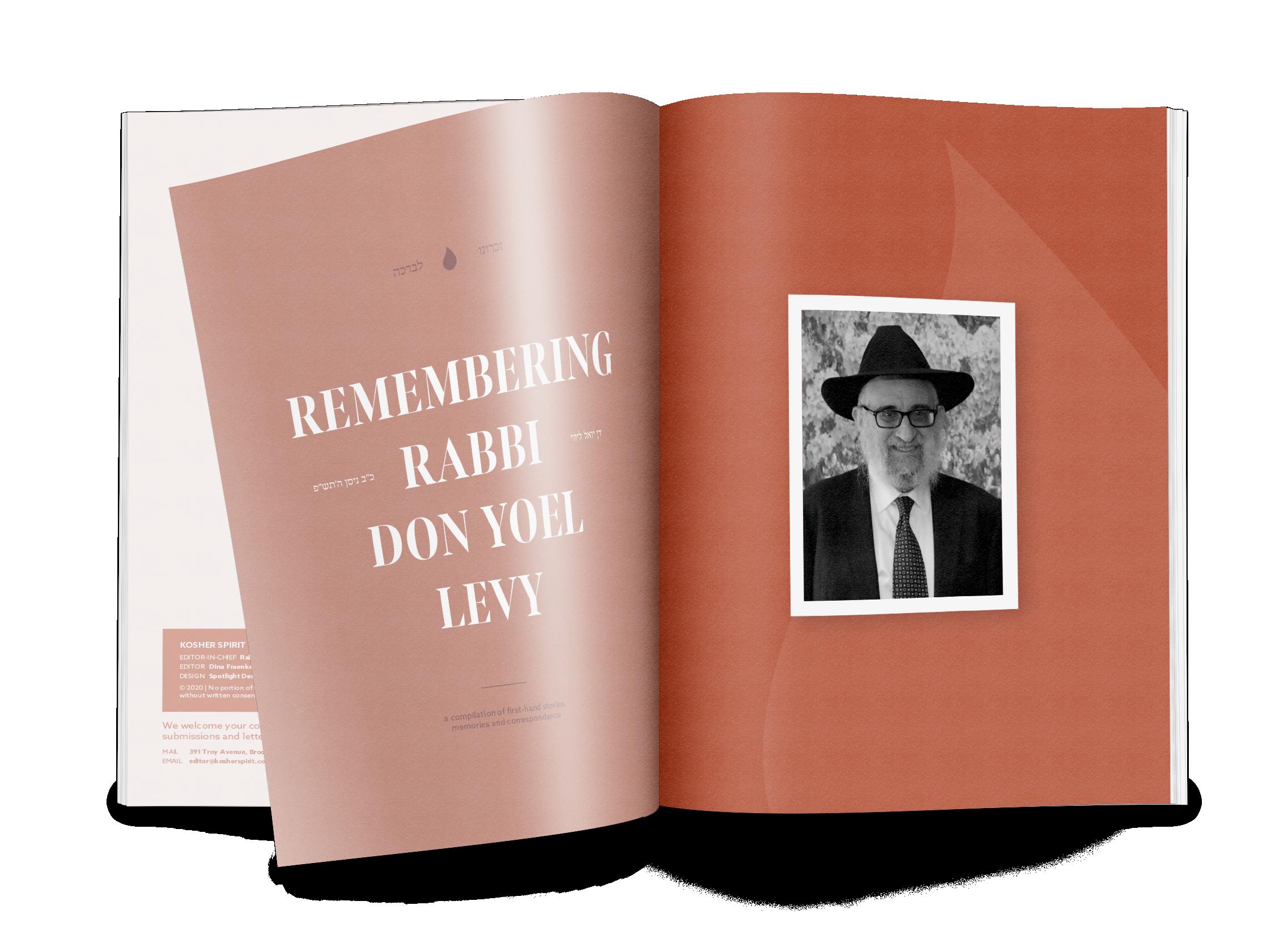
And grasp a deep if not fully understandable ‘connection’.
I want to recognize this difference.
Today I made a conscious effort to search out in Shoprite, where I happened to be, some ~ products I could use for Shavuos. Found some. I will try to get a list of more from your website and add a few items. As I try to eat healthy I cannot get a whole lot, nor change over everything. But I want to show recognition.
FEEDBACK
relaxation,Aidsinsleepandcanreduce stressandhelprelax musclespasms.
badCanhelplower cholesterol clotting;andreduceblood canalsohelplowerblood pressure.
Peppermint
Soothesupset stomach,aidsin constipationand motionsickness; canalsorelieve headachepain.
Tea
lowerCanimproveliverhealth, bloodpressure,and sweets;helpsreducecravingsfor kidneymayalsoprevent stones.
Tea
Containsl-theaninewhich canhelpreduceanxiety andaidinalertnessand attention;L-theanine canalsohelpprevent cognitivedecline.
Green Tea
Can help lower bad cholesterol and reduce blood clotting; can also help lower blood pressure.
Tea Tea
As we sit in our sukkahs, warming up with a hot glass of tea after the seudah, we’re doing more than just relaxing – we’re actually improving our health! Brew yourself a glass of your favorite tea and reap the benefits.
levelsContainshigh whichoftannins have anti-bacterial andantiinflammatory properties.
Tea
Helps combat morning sickness and chronic indigestion; can also relieve joint pain from arthritis.
goodCanhelpincrease improvescholesterollevels; hairandskin health;canimproveblood pressureandcirculation.
KOSHER NOTE: Tea without any additives (pure dried tea leaves) does not need a kosher symbol. Decaffeinated tea, or tea with any added ingredients, requires a reliable kosher symbol.
Green
Tea Tea Tea Chamomile Ginger
Black Hibiscus Rooibos Oolong
www.KosherSpirit.com 5
& Colombia Ecuador
with Rabbi Yoni Rappaport
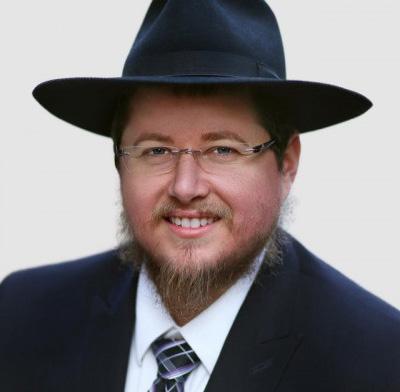
My first stop on this trip was Colombia. I arrived in Bogota on Sunday night, traveled to Cali on Monday evening, and then Barranquilla on Tuesday night. Each morning I was able to daven shacharis at a local shul, where I was warmly greeted by the communities. It’s a bit of a luxury to be able to daven with a minyan on annual visit trips, since the factories are often located far away from a Jewish community. It is truly amazing how Jews have an inherent bond with each other, regardless of where we are from in the world, and can connect anywhere!

6 www.OK.org
RABBI YONI RAPPAPORT
Our Colombian facilities are spread all across the country, so this trip required a lot of flying in comparison to other locales. Most domestic flights go through Bogota, so I ended up in the Bogota airport every day – it did not make for good sightseeing!
Flying throughout a trip adds a logistical challenge, since the inspection schedule revolves around daily flights. It’s also a bit physically unsettling since I end up at a different hotel every night, often arriving very late due to the flight schedule and departing very early the next morning.
While in Colombia I visited facilities that produce nutritional products, dehydrated fruits and vegetables, flavors, candies and soaps.
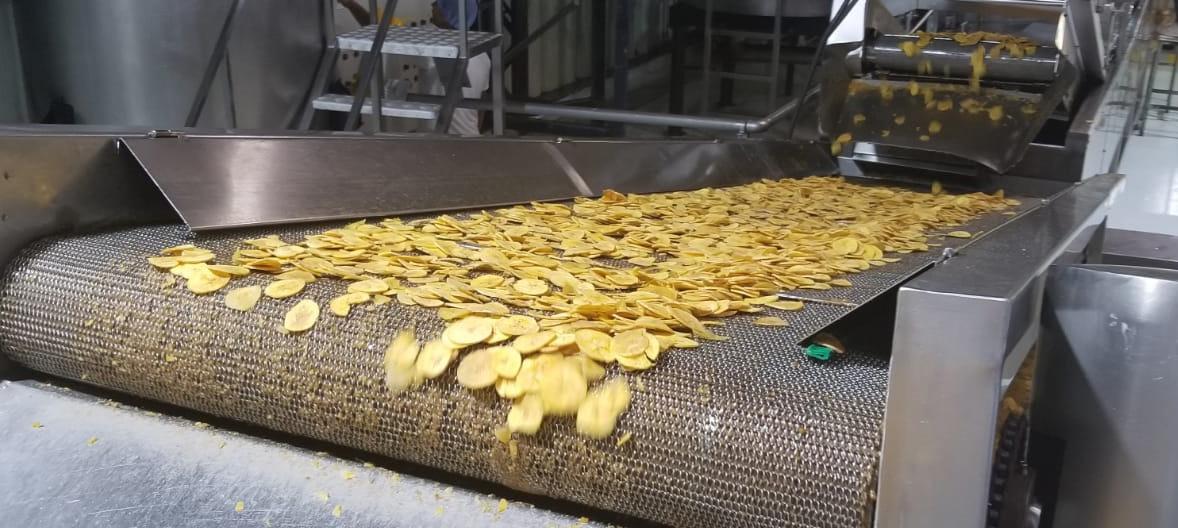
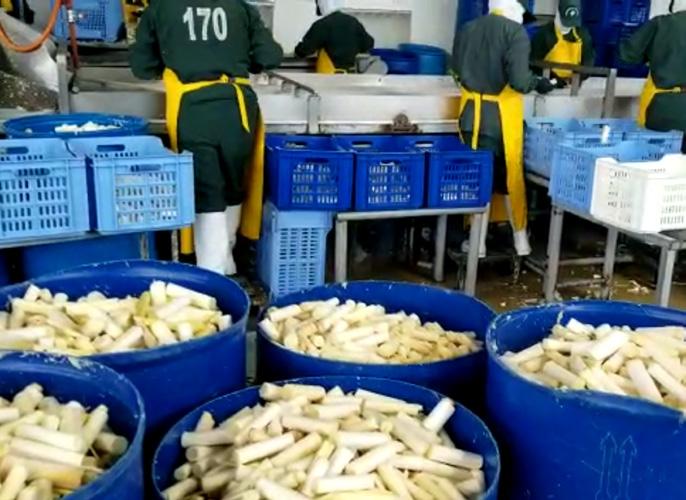
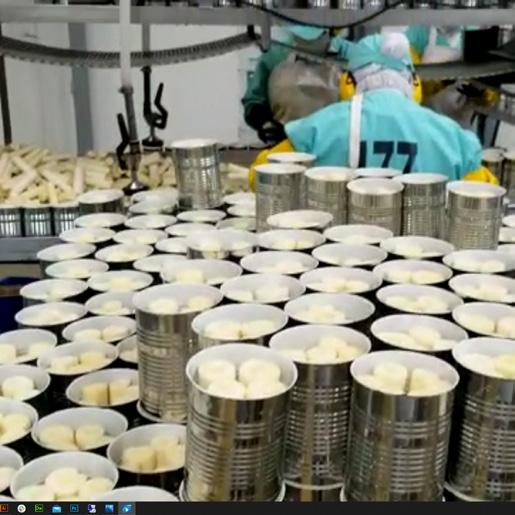
On Wednesday, I flew from Barranquilla to Quito, Ecuador, arriving just after midnight. I stayed at a hotel by the airport and was picked up the next morning by the first Ecuadorian company. This facility produces plantain, cassava and sweet potato chips in the S. Domingo province – about a 3 hour drive from Quito. There I met with our masghiach, Rabbi Uriel Tawil, and afterwards we visited 2 facilities that produce hearts of palm. While driving between the visits we got to enjoy the scenic route from the car window. We arrived at Quito airport that evening and arrived back to the United States early Friday morning.
This trip was quite a whirlwind! ~
5 days travelling
7,253 miles flown
8 flights
410 miles driven
6 cities visited
8 facilities visited nutritional products, dehydrated fruits and vegetables, flavors, candies and soaps, hearts of palm.
by the numbers
hearts of palm plantain chips
www.KosherSpirit.com 7
hearts of palm
Apple Blueberry Turnovers

These are just delicious. Fresh, defrosted, with pie dough or puff pastry. It’s like the comfort food of desserts.
Ingredients
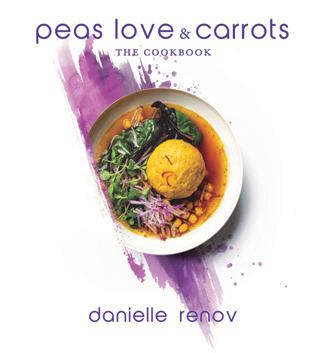
1 pkg (2 rolls) sweet pie dough OR 4-5 sweet pie shells, defrosted and rolled out
4 Granny Smith apples, peeled, thinly sliced
1⁄4 tsp kosher salt
1 tsp pure vanilla extract
1⁄4 cup bourbon
1⁄4 cup brown sugar
2 tsp cornstarch
1 cup fresh blueberries
1 egg, lightly beaten white sugar, for sprinkling
Directions
Place peeled apples into a medium nonstick pot set over medium high heat. Add salt; carefully stir until all the liquid has evaporated.
(Alternatively, you can allow the mixture to cook for 1 minute so the salt can draw out any liquid from the apples, and then drain out water) Once there is no liquid in the pot, carefully add vanilla and bourbon; stir to coat. Cook for 3 minutes until bourbon has reduced by half. Add brown sugar to the pot; stir and cook for 2 minutes.
Sprinkle in cornstarch; stir immediately to combine. Cook for 2 minutes.
Turn off heat; immediately add blueberries. Gently stir to combine.
Set aside to allow mixture to cool completely. Preheat oven to 350°F / 180°C. Line a baking sheet with parchment paper.
Cut pie dough into 6 x 2 inch rectangles.
Using a pastry brush, brush a very small amount of egg on the borders of 2 sides of each rectangle.
Place 1 heaping tablespoon of apple mixture on the first 1⁄3 of each rectangle. Fold rectangles in half so that the apple mixture is completely covered. Use a fork to press the edges of the dough together. Brush the tops with beaten egg and a very light sprinkling of sugar.
Place on prepared baking sheet. Bake for 14-18 minutes until baked through and golden. Cool on baking sheet for 2 minutes, then transfer to a cooling rack to cool completely.
Freezer tip
Once completely cool, lay in a single layer, wrap gently in plastic wrap and freeze overnight. Once frozen, store in a ziptop bag. Remove from freezer 2 hours before serving!
Variation
You can absolutely trade the puff pastry for store bought sweet pie dough. In Hebrew it is called batzek parish matock, and it is delicious!
Excerpted from Peas Love and Carrots by Danielle Renov. Copyright 2020 by ArtScroll Mesorah Publications, photos by Moshe Wulliger. Reproduced with permission of the copyright holder. All rights reserved.
Kosher Transport
By Rabbi Don Yoel Levy
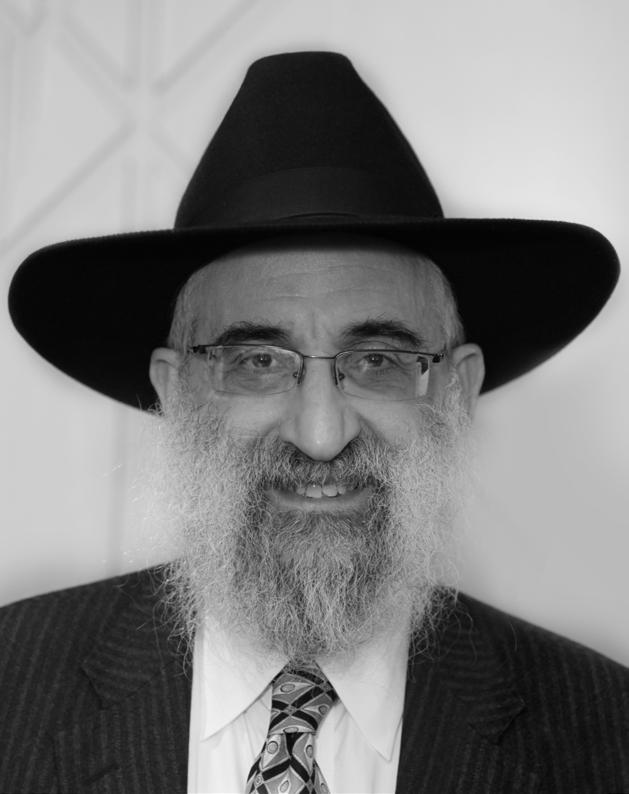
Wmethods, equipment, etc. But another vital issue that must be addressed is transport. How do kosher products get from one factory to the next and, ultimately, to stores and your kosher kitchen?
The food that reaches our table may come in a box, glass bottle, plastic bottle, or similar one-time use container. These containers are disposable, and generally do not present a kashrus issue. Even soda and beer bottles and the like, which are returned for a five cent deposit, are recycled and melted down (at very high temperatures) into new products, so again there is no kashrus concern. (For Pesach, bottle return could present a problem, so we ensure the use of new bottles for Pesach.)
In food production facilities, ingredients may also come packaged in cartons, disposable drums, totes, bags, etc. Generally speaking, these packages are one-time use containers, similar to the disposable packaging found in your home. Therefore, these containers do not usually present any kashrus concern.
Nowadays, however, there are a myriad of ingredients used in the production of kosher foods that are not packaged at all. Rather, these bulk ingredients are transported from their production sites to other factories or to storage facilities via trucks, trains, or tankers.
Some bulk ingredients are transported cold and others are heated during transport. According to Jewish law, when hot non-kosher products are kept in a vessel, the walls of that vessel absorb the non-kosher material. When a hot (kosher) product is subsequently placed into that vessel, the non-kosher within its walls is transferred to the product, rendering it not kosher. This is true for trucks, rail cars and tankers, as well as general holding tanks where bulk products may be stored until use.
Therefore, the kashrus industry must monitor that the tanks used for kosher transport are used only for kosher ingredients. If non-kosher products have been transported or stored in a tank, that tank needs to be kosherized before it can be used for hot kosher product.
Over twenty-five years ago, in the early 1980s, when we realized that potentially problematic tankers and railcars transported oils and other ingredients, an official system was set up in the USA to monitor trucks transporting domestically.
Even before that time, my father, Rabbi Berel Levy ob”m, was already a pioneer in visiting companies in the Far East whose tropical oils were

REMEMBERING
LEVY OBM יוויל לאוי ןד ברה ב״כ
RABBI DON YOEL
ונורכז הכרבל
www.KosherSpirit.com 9 This article was originally printed as a two part series in 2007.
Kashrus Administrator of ~ Kosher Certification 1987-2020
being shipped to the USA. He discovered that oils were shipped from the Far East on big tankers and brought to various ports in Europe and the USA, and there was no monitoring of these tankers at all. Understanding the seriousness of this situation, my father began to investigate.
The first step was to collect information about the ships and how they operate. It was not easy, as the information we got from the various shipping companies was not always consistent.
For example, we visited a large shipping company on the East Coast and were told that ships bringing in oils from the Far East usually went back and forth between the Far East and the West Coast, boats traveling from Europe came only to the East Coast.
At that time, before the onset of “Mad Cow Disease,” animal products were extremely prevalent in Europe. Fish oil was also widely used at the time. So the ~ further inquired about the shipping routes of boats bringing in oils from the Far East, and they assured us that the boats definitely traveled the pattern described above – from the Far East to the West Coast and from Europe to the East Coast.
From the information we had then (information which proved to be not so accurate), we could assume that virtually no animal products were being shipped to and from the
Far East, as they were between Europe and the East Coast. If ships traveling between Europe and the East Coast did not go to the Far East, it seemed to alleviate the problem of kosher transport from that part of the world. Unfortunately, though, it was not true.
At the time of my investigations, I asked to visit a ship, and it was arranged for me to visit a ship in the New York area. Imagine my surprise and distress when the captain informed me that the ship was on an around-the-world trip!
Clearly, we needed to know the previous cargoes of the ships bringing kosher oils from the Far East, and elsewhere. My father, Rabbi Berel Levy, ob”m, set up a rudimentary system, with the advice and guidance of Hagaon Reb Moshe Feinstein ob”m, which enabled the ~ to amass the necessary data. We began to collect information on the types of cargoes that are commonly shipped. Today we have amassed a tremendous list of kosher and non-kosher cargoes.
Because it turned out to be quite complicated and difficult to collect a history of all the previous cargoes, based on the p’sak of Rav Moshe Feinstein ob”m, we established a system of checking at least the last three cargoes. If these are acceptable for kosher, we can consider the tank suitable to transport or store kosher product.

A few years later, after my father’s untimely demise, I started visiting facilities in Europe, and discovered that they had absolutely no system at all for monitoring incoming oils.
Croklaan Oil Company (now IOI) invited me to visit their facility. I insisted on visiting the port at Rotterdam as well, where I realized that the problem extended beyond the ships’ tanks. The oils and fats arriving from the Far East were stored at huge tank “farms” in Rotterdam, which of course were not monitored for kosher. Although many kosher companies and agencies were producing oils in Europe, including the most respected kashrus organizations in Israel, NO ONE was checking the ships that brought the tropical oils from the Far East, or the storage facilities where they
were being stored in nonkosher tanks.
Additionally, when the oils arrived at Rotterdam, they were offloaded to the storage facilities and factories via barges on the famous Dutch canal system, or by road tankers. Of course, the kosher status of the barges and road tankers also needed extensive monitoring.
Europe was a complete wilderness as far as transport was concerned. Our efforts were made more difficult by the fact that no other kosher agencies required kosher transport. Fortunately, our contact at Croklaan Oil, Mr. Jan Kat, completely understood the severity of the situation. He cooperated fully with the ~, and we worked very hard to set up a system to monitor the incoming ships, the tank farms, the barges and the road tankers.
10 www.OK.org
In addition, it is worthwhile to note that today, in Europe, the ~ is the only certification agency that monitors the transport of ingredients by road tankers. [Ed. Note: B"H, today there are other kosher agencies that monitor road transports as well.]
Today the ~ certifies many oil and oil by-products from the Far East, and we have a responsibility to kosher producers and consumers the world over to see that they are shipped in kosher transport.
Bulk shipments of liquids from the Far East are shipped in large tankers (called ISO tanks) or in ship hold compartments. ISO tanks are manufactured according to specifications from the International Standards Organization (ISO) and are suitable for multiple transportation methods such as truck and rail, or rail and ship.

In the last few years, ~ Kosher Certification has taken a leading role in the effort to track these shipments and ensure that kosher product is shipped in acceptable tanks that will not affect the kosher status of the product. A Kosher Certificate must accompany each shipment for transport, certifying that the ~ has approved the tank. Only tanks that have been steamcleaned at a temperature of at least 100° C (212° F) for at least ½ hour, and whose previous three cargoes did
not contain any non-kosher material, can be approved.
The steam cleaning process can be carried out in multiple ways. For a ship’s compartment, builtin steam pipes flood the compartment with steam, while an ISO tank is steam cleaned by inserting a pipe, with a steam ball attached to the end that floods the tank with steam. The steam ball is a metal ball with many holes, which rotates to distribute the steam onto every surface of the tank. An independent inspector, known as a surveyor, who is monitored by a regulating agency, ensures that the tank or compartment is clean, steamed to 100° C (212° F) and approved for loading, and must corroborate the cleaning information.
Since it is not possible to have a Mashgiach present at every bulk loading (there are hundreds each week!), an in-depth review of the shipping documentation is necessary in order to ensure that our standards are met. ~ personnel developed a detailed three-step procedure, and a full-time position was created in our office to process the dozens of applications we receive each day. [Ed. Note: As of the time of this printing, the ~ receives an average of 900 ISO tank applications per month.]
For a detailed description of the ISO tank process, please visit https://www.ok.org/kosherspirit/ winter-2008/kosher-transportpart-ii/~
www.KosherSpirit.com 11
IN THE LAST FEW YEARS, ~ KOSHER CERTIFICATION HAS TAKEN A LEADING ROLE IN THE EFFORT TO TRACK THESE SHIPMENTS AND ENSURE THAT KOSHER PRODUCT IS SHIPPED IN ACCEPTABLE TANKS THAT WILL NOT AFFECT THE KOSHER STATUS OF THE PRODUCT.
First FRUITS ST
An Overview of the Laws of Orlah
By Rabbi Sholom Ber Lepkivker, ~ Rabbinic Coordinator
It’s Erev Rosh Hashanah and the table is set beautifully, with the tray of apples and honey prominently in the center. Of course, everyone has their personal favorite type of apple – the Gala, the Honey Crisp, the famous Red Delicious... But, there is a new variety of apple on the market that has taken the United States by storm with its instant popularity. The Cosmic Crisp (scientific name WA-38) is an apple with dark red skin, like the color of wine, creamy white flesh, a pleasant flavor and an extended shelf life. It is so dense that the apple feels heavy when held.
Like all apples, the Cosmic Crisp consumes oxygen through what the consumer might think of as spots or freckles, but which are really tiny pores in the skin, called lenticels. The Cosmic Crisp apple’s lenticels look exceptionally bright against its inky skin, reminiscent of stars in the night sky, an observation that was branded into the trademarked “Cosmic Crisp” name.
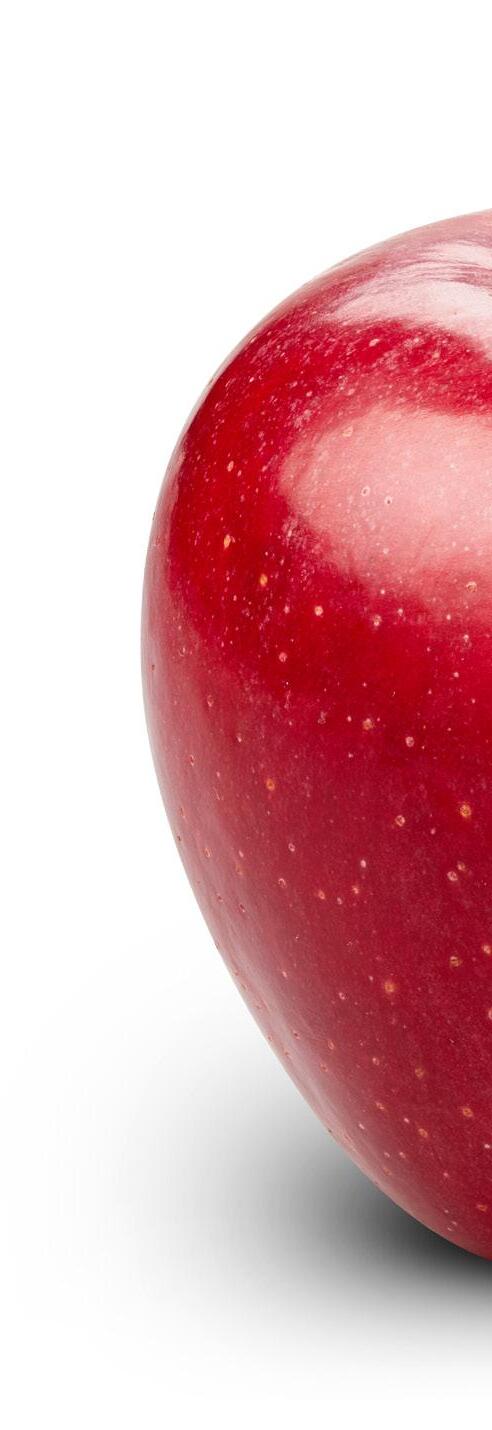
1
12 www.OK.org
The apple tested so well that Washington State University (where the variety was developed), in collaboration with commercial nurseries, began producing apple saplings as fast as possible; the plan was to start with 300,000 trees, but growers requested 4 million, leading to a lottery for divvying up the first available trees. Within three years, the industry had planted 13 million Cosmic Crisp trees.
The variety was first planted for commercial use in Spring 2017, with 12 million trees pre-ordered by Washington orchards. Cosmic Crisp apple trees were initially only available to Washington-based growers, and will remain limited to them for at least ten years.
Proprietary Variety Management expects that the number of Cosmic Crisp apples on the market will grow by millions of boxes every
year, outpacing Pink Lady and Honey Crisp within about five years of its launch.
Though Washington State University owns the WA-38 patent, the breeding program has received funding from the apple industry, so it was agreed, over some objections by people who worried that quality would be diluted, that the variety should be exclusively available to Washington growers.
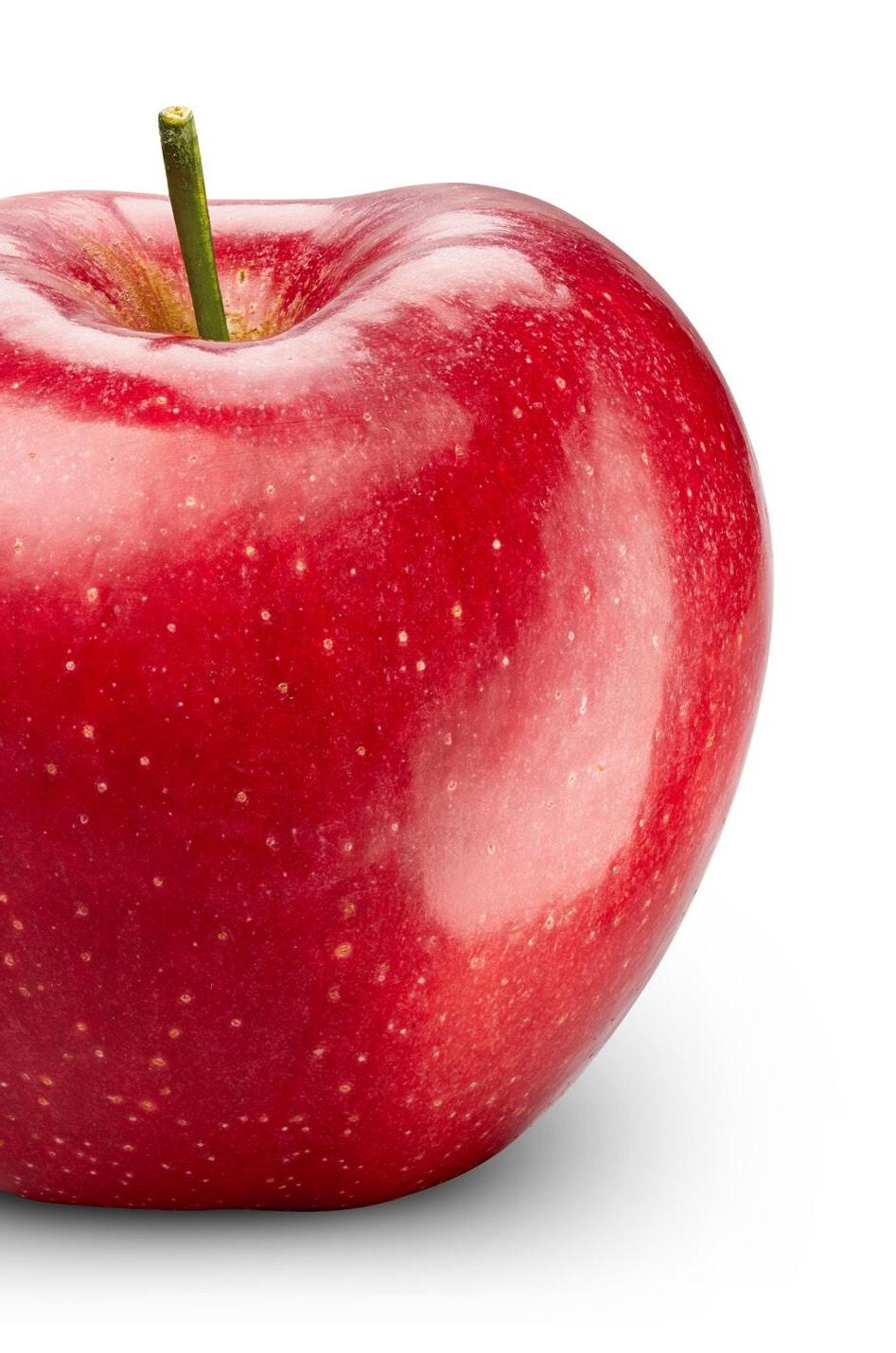
As with any new variety of fruit, the Cosmic Crisp apples raise a question among kosher consumers. Is there a concern of orlah with these fruits which were all grown (fairly) recently? As mentioned, the trees only became available to growers in Spring 2017, so should we concern ourselves with the possibility of orlah?
The Source of Orlah
The Torah tells us:
Once the Jewish people came to the Land of Israel, all fruits grown on newly planted trees could not be consumed, sold, gifted, or used for any form of pleasure for the first three years. At the conclusion of the third year, the fruits are considered holy and can only be consumed in Yerushalayim. Only at the beginning of the fifth year are the fruits considered “mundane” and can be sold and consumed in a regular manner. The Torah only speaks explicitly about fruits that grow in the Land of Israel, but the prohibition against orlah fruits includes those which grow outside of Eretz Yisroel2, as well.
The source of this prohibition isn’t learned plainly from the Torah, rather it’s a law passed down from generation to generation begin-
ning with Moshe Rabbeinu – Halacha l’Moshe miSinai3.
Generally, Halacha l’Moshe miSinai has the same power as any law from the Torah itself, but in this case there is a leniency, which usually only exists with laws of rabbinic origin. If there is a doubt about the orlah status of a fruit grown outside of Eretz Yisroel, it is allowed as long as it’s not clearly from the forbidden tree4. The Beis Yosef and the Rem”a have differing opinions about the harvesting of fruit in doubt. The Beis Yosef permits one to even collect the fruit himself, while the Rem”a permits one to observe Gentiles collecting the fruit.5
The leniency towards fruit grown outside of Eretz Yisroel is so great that even if there is a good chance that the fruit is orlah, or even if it’s a “phone call away” to find out the truth of the matter, the fruit is still kosher6. In Eretz Yisroel the fruit is forbidden until proven kosher, but outside of Eretz Yisroel, it’s permitted unless proven non-kosher.
... ץראה לא ואֹבת יכו 1.םכיקֹלא ’ה ינא
1 גכ.טי ארקיו 2 ח ףיעס ד”צר ןמיס ד”וי ע”וש
3 טל ’ד ןישודיק 4 םש 5 אכ ק”ס םש ד”וי ך”ש 6 גי ק”ס םש ד”וי הבושת יחתפ www.KosherSpirit.com 13
Timing it Right
The permissibility of fruit depends on the tree reaching the age of 3 years old (beginning the 4th year), so timing the planting is very important. The Halacha is, that as long as the tree was planted at least 44 days before Rosh Hashanah (before 16 Av), the first partial year can be counted as a full year. This calculation is based on the principle that it takes 14 days for the tree to settle into its current location plus another 30 days, as in other halachic cases where 30 days can be considered a year for the planting of trees.
Regardless of the planting date, the fourth year cannot start before Tu B’Shvat, because the growth started before the end of the third year. So, with correct planning, it takes a minimum of 2 years and 44 days, plus the four and a half months from Tishrei to Tu B’Shvat to complete the three-year orlah prohibition. If the trees were planted after 16 Av the fruits are forbidden for 3 full years, plus the four and half months until Tu B’Shvat.
What is Included in the Prohibition?
The laws of orlah apply to fruits grown by both Jews and Gentiles.7 The entire fruit, including the skin, seeds and flower, is included in the prohibition and one cannot derive any pleasure or benefit from the fruit or tree. One cannot remove the seeds to plant them, or even ask a Gentile to take the seeds, since this would cause the Jew to gain favor from the Gentile. This particular law only applies to fruits which grow in the Land of Israel and
not to fruits grown outside of it8. Outside of Eretz Yisroel, only the fruit itself is forbidden.9
If seeds from an orlah fruit were mistakenly planted, then b’di’eved the tree is “kosher” once three years have passed, because of a factor called “ םרוג הזוהז” (which means that the soil which isn’t forbidden) has played a key role in producing this fruit.10
Preemptive Measures
Though orlah fruits cannot be used in any way, one is allowed to sell the fruits to a Gentile ahead of time (before they have sprouted), because there is no prohibition against orlah fruits when the fruits do not yet exist.11
If a Jew and Gentile are partners, the Jew may not take triple his share of the fruit after the three years to make up for the three years that he could not partake in the harvest unless he planned this with his Gentile partner in advance. According to the Beis Yosef, the partners need to make a proper legal agreement in advance, but according to the Rem”a if the Jew merely tells the Gentile the plan it is sufficient.12
7 ח ףיעס ד”צר ןמיס ד”וי ע”וש
8 ’ג ףיעס םש ע”וש 9 א»ע ז»ט 10 ב”י ףיעס םש 11 ו”ט ףיעס םש 12 ג”כ ק”ס ז”ט לע ףסכה תודוקנ הארו ג”י ףיעס םש 14 www.OK.org
What Types of Trees Are Included?
The count of three years does not necessarily begin when the tree is still a seed, rather the count begins once the tree is planted in the ground.13 The tree could be fully grown, but if it was replanted after being completely detached from the ground the three year count begins anew.14
•If enough soil was left on the roots for it to survive for three years15 (in Eretz Yisroel) or for even a few days outside of Eretz Yisroel16, one does not need to observe the laws of orlah once the tree is replanted.
• If the tree was planted for its wood (not for its fruits), or to be used as a fence or barrier, the laws of orlah do not apply. This is contingent upon the intention being evident (for example: the trees are grown too close to grow in a proper manner to yield good fruits).17
• If a tree was planted with a dual intention, to use one side for fruits and the other side as a fence (and the intention was evident), the fruits from the side that was meant for food are forbidden for the first three years, while the rest are permitted as long they are eaten at random (and not intentionally harvested).18
A wild tree that grew on its own in a harsh land is not subject to the laws of orlah. It should be clearly
evident that the tree was not cultivated or tended.19
The Fruits of the Fourth Year 20יעבר עטנ
As mentioned before, the fruit of the fourth year have a special status as well and can only be consumed in Yerushalayim. Since this is no longer practical, the fruit of the fourth year must be redeemed21 with at least a prutah22 (which is worth a small amount of money today) or fruit of that value. The holiness of the fourth year crop is then transferred to the money or the fruit which is being exchanged. The money or fruit must be destroyed or thrown away in a manner that it will not be found. There are three opinions about the application of the law of the fourth year outside of Eretz Yisroel:23
Rabbeinu Yonah holds that the law is the same outside of Eretz Yisroel.
The Rambam holds that the law does not apply outside of Eretz Yisroel.
The Rosh, Tur, Ramban, Tosfos and many more hold that generally the law does not apply, unless it is a grape, which has a special significance.24
The Gr”a holds that the Halacha is like the third opinion. When redeeming these fruits one must say a brocha, but when grown outside of Eretz Yisroel, the Shach says that
one should make a brocha without shem u’malchus.
If the fruit belongs to a Gentile, the Rambam25 holds that the fruits are only holy if the Gentile wants them to be holy; otherwise, they may be consumed in the usual manner.26
Is the Cosmic Crisp Kosher?
The answer is, “Ess gezunterheit!”
The Cosmic Crisp saplings are prepared in the nurseries in a special way. The trees are grown in pots for at least two years, cooled, and then replanted later on. A significant amount of dirt is left attached to the roots and these saplings are usually dug up in January and then replanted in May, which eliminates the need to count the orlah years from when the trees are replanted.
Even though there is a chance that the fruit is orlah, there is also a chance that it’s not orlah. If the fruit was grown in Eretz Yisroel, there would be an issue of orlah, but because we are in Chutz L’Aretz (outside of Eretz Yisroel), even the slightest doubt of the orlah status makes this fruit halachically acceptable. ~
ז”ט ףיעסו ’א ףיעס םש 14 ט”י ףיעס םש 15 Or fourteen days according to some Poskim. 16 םש הבושת יחתפ 17 ג”כ ףיעס םש 18 א”ע י”פ ם”במרב הנומא ךרדו םש
13
19 ז”כ ףיעס םש 20 ’א הנשמ א”פ הרפ ’סמ 21 ’ו ףיעס םש ע”וש 22 א”כ ק”ס םש א”רג האר 23 ’ז ףיעס םש ע”וש 24 ב”י ק”ס םש ז”ט
25 ’י ’לה י’’פ ינש רשעמ תוכלה 26 ’ח ףיעס ד”צר ןמיד ד”וי ןחלשה ךורע דוע הארו www.KosherSpirit.com 15
FROM ESTHER TABAK AND HER FAMILY
“When I think of Savta, I think of her graced with royalty, sparkling with Simchas Hachaim; a regal and dynamic individual. Every one of her grandchildren and great grandchildren were her favorites! She loved each one of us and we loved her. She was everyone’s beloved Savta not only ours.

FROM SARA ROSENFELD
What sticks out in my mind about Savta is a life always with a purpose. Whether involved in the kashrus field, or to put her life in danger to help Yidden in Russia, or to be an unbelievable grandmother, great grandmother, and great-great grandmother to all of us children. She showed us that the purpose of life is not to be for oneself but to do whatever one can to help others.
The day Savta was nifteres, I came home early from work. I walked into my house crying for Savta. My housekeeper was there at the time. She asked me what happened. I told her Savta passed away and she started crying bitter tears. “I remember Savta,” she said. “She always referred to me as ‘Kristina’, not ‘housekeeper’!”
This incident is only a small example of the profound impression Savta left on other people!
FROM RABBI YOSSIE GARTENHAUS
We were zoche to have Savta in our home for ten years for the Yom Tov of Pesach. She was already in her nineties and would stay up for the Sedorim from beginning to end, following the Haggadah and adding her words of chizuk and emunah. She would refuse to go up to sleep until the end of the Seder at 3:00 A.M. Her days of Yom Tov were spent davening, saying Tehillim and giving her einiklach words of chizuk.
Another memory comes to mind: I went to visit Savta in the Rehab Center in Boro Park. She was telling me what she eats. I asked her, “Savta why don’t you wash and eat some bread?” Her reply shocked me. She had trouble with her eyesight and had difficulty reading. She told me that she was always makpid to bentsch from a Siddur. Since she couldn’t read, she didn’t want to wash because she would then be unable to bentsch from a Siddur. This is who my grandmother was!
Reflections from Her Grandchildren
MRS. THELMA LEVY A”H
BY CHUCKY GARTENHAUS
On Taanis Esther of this year, my brother Yossi and I drove from Lakewood to Brooklyn to read Megillah for our parents. As we drove down the Prospect Expressway we decided to stop by the home of our Savta in Crown Heights to wish her “Happy Purim”. While we were calculating whether we had the time to make the stop, one us mentioned that if this was the last time that we would be able to see Savta and we passed on the opportunity, would we ever be able to forgive ourselves?
We ended up going to Crown Heights to visit Savta, as we have done so many times over the years. She was resting in her bed, having just come down with a small fever. The doctor said she probably had an infection and they were scheduling a chest x-ray for the next day. As the doctor was checking her out we sat and spoke to our uncle, Reb Don Yoel, who happened to be there as well. Who knew at that time that it was the last time we would see him?
The image of Savta lying in her bed with her finger pointing to the chair next to her bed, beckoning me to sit down next to her, is indelibly etched in
16 www.OK.org
MOTHER OF RABBI DON YOEL LEVY OB”M
my mind. She just looked directly into my eyes, took my hand, and thanked me for coming to visit her. We sat for a while, mainly in silence, because she was too weak to talk, and then she smiled and told us to go on our way so that we would not be late to our parents.
Savta did not have an easy life. At every turn, as long as I can remember, she was faced with adversity, pain, loss, and heartbreaking suffering. I had the zechus to visit her in Crown Heights very often and when I would ask her how she was able to move on during these times, she would look straight into my eyes and tell me: “This is what the Aibishter wants from me; who are we to question His ways?”
Savta was a fountain of emunah. As a young girl she understood the importance of growing in Torah and observance and every time Savta spent Yom Tov at my home, I would tell my children how special it was that a large family can descend from one person who sacrificed everything to marry a yeshiva bochur and lead a life of Torah and avodah.
SAVTA’S GEMS
Anyone that would spend a few minutes wtih Savta would inevitably hear about her “gems” – her great-grandchildren. She always had tremendous pride in her family and would let everyone know about it! Savta knew the names and birthdays of practically all of her grandchildren and great-grandchildren, as if they were her own kids. I would always get a call around Pesach time, every single year without fail, wishing me happy birthday and telling me, “I can’t remember the exact date but I know it was around Shabbos HaGadol.”
Savta had a special ability to watch a child for a few minutes and understand what that person needed from her as a grandmother. My daughter Rocheli is very artistic and Savta never ever missed the opportunity to ask her to draw for her and bask in Rocheli’s smile as if it was the only important thing in the world. Anytime she would see my son Meir she would remind him of how well he treats her in our home, always offering her a drink anytime he would pass by her. Savta used to always ask me if I could get my boys to learn next to her so she could hear the sound of their Torah learning. It didn’t matter if
she could follow along in their learning; just watching them sit and learn was all the nachas she needed.
For the past twenty years, Savta spent the majority of the Yomim Tovim in Lakewood at the home of one of her grandchildren. She would call me before each and every Yom Tov to discuss whose turn it was to host her. She told me that, chas v’sholom, she would not want to insult someone by skipping their turn to host her!
Savta always spent Purim at my house. She would sit by the table watching groups of people coming in all day, one after another, saying Divrei Torah, and you could just see her eyes light up when they would ask her if she would like to listen. No matter how hard it was for her to walk, Savta insisted on going down the block to our neighbor to hear the Megillah. She was never one to use her age or her condition as an excuse to pass on a mitzvah, whether it was Megillah, eating in the sukkah, Chanukah candles, etc. The last time she was in my house for Purim, two years ago, she was in no condition to walk to hear Megillah. I came up with a plan that I would bring Zaidy’s Megillah that was sitting in her house, untouched since his petirah, and I would get someone to read from it for her in my home. Tears come to my eyes when I picture the scene of her standing over the Baal Koreh as he slowly unfolded the Megillah from the silver case. Her body shook and tears flowed freely down her face as she listened to the Megillah and recalled memories of Zaidy Berel Levy.
THAT
Savta lived alone after Zaidy’s passing, never asking anything from anyone, but commanding everything through the pure respect and love she showed all of us every day of our lives. She left us in the same manner as she led her life, no fanfare, no running after respect, humble as can be. What she did leave us with is a life full of sweet memories; her sharp gaze will never be forgotten, her mesiras nefesh to build our family will never be underappreciated. Like my mother said to us shortly after Savta’s petirah, “The trio of Savta, Zaidy, and Reb Don Yoel up in shamayim, davening for our family, is not to be underestimated.” ~
www.KosherSpirit.com 17
ANYONE
WOULD SPEND A FEW MINUTES WTIH SAVTA WOULD INEVITABLY HEAR ABOUT HER “GEMS”
— HER GREAT — GRANDCHILDREN.
What is Bitul?
WHAT IS BITUL?
When non-kosher food is accidentally mixed with kosher food, the non-kosher item can be, under certain conditions, considered nullified (batul) and the finished product still kosher. This largely depends on the ratio of the permitted substance to the prohibited substance.
In most cases, the prohibited substance has to be 1/60 or less. Meaning, if 1 gallon of non-kosher food falls into at least 60 gallons of kosher food, the finished product is still kosher and okay to eat. There are some exceptions to this rule. Some prohibited foods only require a simple majority to be nullified, some require a higher level of nullification such as 1/100 (terumah) or 1/200 (orlah) and some can’t ever be nullified. All of this will be explained below.
ITEMS THAT ONLY REQUIRE A MAJORITY:
1. If a solid non-kosher food is mixed with similar kosher food it will be nullified in a majority as long as they were not cooked together (example: 1 slice of non-kosher raw fish that was mixed with 2 slices of kosher raw fish and there is no way to identify the non-kosher fish). Nevertheless, one person may not cook or eat the entire quantity of the mixed food. The same rule would apply if a pot of non-kosher food was placed near two pots of identical kosher foods and the non-kosher pot remains separated but cannot be identified.
2. If the non-kosher item has a foul taste or adds a bad flavor to the dish, it is considered nullified in a simple majority because one is not enjoying the issur.
ITEMS THAT REQUIRE MORE THAN 1/60:
1. 1/100 is necessary to nullify terumah (priestly gift from Israeli produce) and Challah (the dough separated as a priestly gift). Both are holy and cannot be consumed by a non-priest or tamei.
2. 1/200 is necessary to nullify klei hakerem (a prohibited crossbreeding of grapes with other plants) and orlah (fruit from a tree within its first 3 years) in Israel.1
1 If there’s safeik orlah (the nature of its orlah status is unknown) in
ITEMS THAT CANNOT BE NULLIFIED:
1. Chometz that is mixed into a Kosher for Passover item during Passover cannot be nullified.
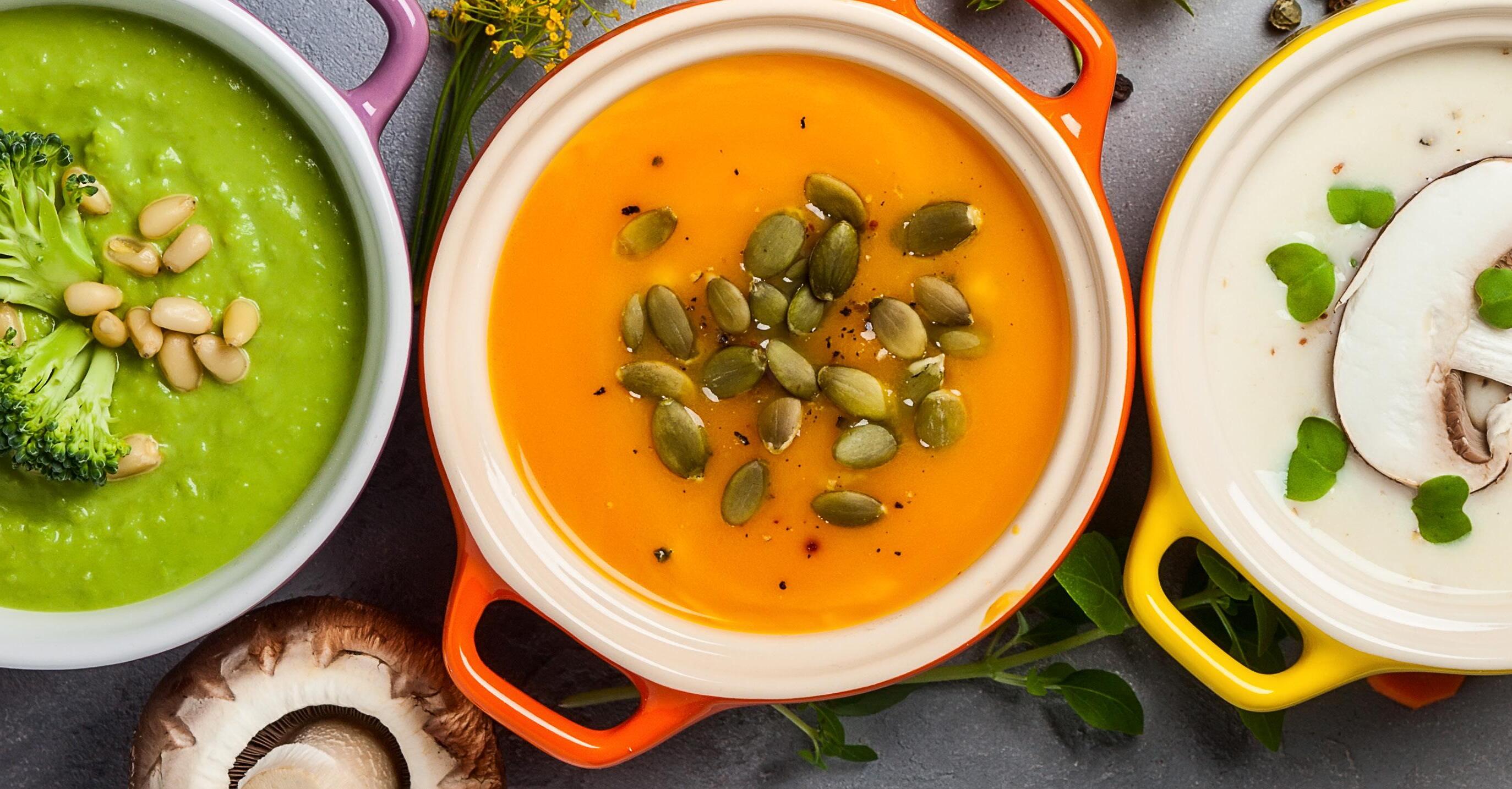
2. Foods that have a certain significance and are prohibited by themselves (and not an absorption of an issur) as defined below.
a. Beria - A whole creature, such as a bug, or the complete limb (removed from a live animal) cannot be nullified. If it was crushed (pulverized) without the intention to make it batul, i.e. for the purpose of a smoothie, it is permitted.2
b. Chaticha Haroya Lihischabed – A food that is respectable to serve, such as a piece of steak or a nice piece of fish cannot be nullified. If one nice piece of non-kosher meat is added to a cholent with other similar pieces of kosher meat and there is 1/60 ratio of non-kosher meat to kosher meat, the pot is still considered kosher and potatoes and beans are allowed to be consumed, but none of the meat may be consumed.
c. Davar Shebiminyan - Something that is sold by the amount rather than weight, such as eggs which are sold by the dozen cannot be nullified.
d. Something that is intended to add flavor, such as a spice, cannot be nullified as long that the flavor is noticeable.
3. Davar Hama’amid – something that is used to solidify food, such as rennet in cheese, cannot be nullified.
4. Davar Sheyesh Lo Matirin – An item that isn’t permitted right now but can/will become permitted eventually (without nullification), such as an egg laid on Yom Tov and Tevel (Israeli produce before Teruma and Ma’asros [Priestly gifts and tithes for the Levites and the poor]
produce that grew outside of Israel, it is permitted. See article about orlah in this issue for further information.
2 After fruits with infestation concerns have been washed well, one may crush them without checking for insects because the intention is not to cause bitul. (See Pitchei Teshuva YD 84, 10)
18 www.OK.org
Rabbi Sholom Ber Hendel ~ Kosher Vaad HaKashrus & Rabbinic Coordinator
were separated) cannot be nullified when mixed with the same type of food, because the Chachomim did not want to rely on the leniency of bitul when the item would be permitted at a later time (after Yom Tov) or after an action (hafrashas Teruma and Ma’asros).
OTHER IMPORTANT THINGS TO NOTE ABOUT BITUL:
1. One cannot purposefully nullify an item by adding more of the kosher product so as to make the non-kosher item 1/60, or change the status of a beria/chaticha hareoya lehischabed, in order to cause bitul. Bitul only applies if there was a non-kosher item added accidently and the ratio was 1/60 or less from the start.
2. In general, if the non-kosher item is recognizable within the mixture, such as a piece of meat falling into a pot of milk, the piece itself must be removed and cannot be nullified (the flavor that remains can be nullified in a ratio of 1/60).
3. When attempting to calculate whether an item can be nullified or not, it must be calculated by volume and not by weight. A majority of food companies measure their products by pounds and kilos rather than by volume (such as liters and gallons). Therefore, the volume must be appropriately calculated in order to determine if the non-kosher item can be nullified.
HOW TO CALCULATE WHEN THE VOLUME IS NOT KNOWN:
The “specific gravity” of each item will represent the density. Products with higher specific gravity are denser. The specific gravity of water is 1. When nullification is calculated, the weight needs to be divided by the specific gravity.
For example, the specific gravity of malt syrup
is 1.41. 1 pound of malt syrup needs to be divided by 1.41, which equals a volume of 0.709. 0.709 multiplied by 60 is 42.5. This means you must have 42.5 pounds of water to nullify a single pound of malt syrup.
Another example is animal fat. Its specific gravity is 0.9 which means that 1 pound of animal fat, divided by 0.9 equals 1.11. In order to nullify the fat, 66.66 pounds of water is needed.
Another way to measure the volume is to convert the weight into gallons which is a measurement in volume. One gallon of malt syrup is 11.71 pounds, so 1 pound of malt syrup is 0.085 gallons. 5.1 gallons of water is needed to nullify one gallon of malt syrup. A gallon of water weighs 8.34 pounds, so 42.53 lbs. of water are needed to nullify 1 gallon of malt syrup.
Similarly, a gallon of animal fat weighs 7.5 pounds so 1 pound of animal fat is 0.133 gallons and we need 7.98 gallons of water to nullify 1 pound of animal fat. 7.98 gallons of water weigh 66.55 lbs3
If one doesn’t know how to calculate the volume it cannot be considered as a safeik because the doubt is caused by a lack of knowledge, not a true case of doubt.
~ Kosher only certifies products that are kosher without relying on nullification. This means that 100% of the ingredients must be approved as kosher in order for the finished product to be ~ certified.
3 The small discrepancy in the final numbers is due to rounding to the nearest hundredth for the purpose of this article.

www.KosherSpirit.com 19 a closer look www.KosherSpirit.com 19
WHO’S BEHIND THE ~
Interview with Reb Eli Methal
KS: Where did you grow up?
Where did you go to yeshiva?
EM: My father, a”h, was a Holocaust survivor who spent four years in the camps and he married my mother, a”h, who was living in Crown Heights at the time. I was born there and then moved around within Brooklyn during my childhood. As a bochur, I attended Yeshiva of Eastern Parkway.
KS: What did you do after yeshiva?
EM: After yeshiva I continued my education and earned a Bachelor’s Degree in Education and History, as well as graduate studies in Public Administration. I married my wife, Susan, in 1974 and moved to the Flatbush area of Brooklyn. Prior to my career at the ~, I spent 32 years working for the New York Housing Authority in several administrative positions.
KS: What is your current position at the ~?
EM: I have 2 distinct positions at ~ Kosher:
1. I evaluate and approve products submitted daily by ~ certified companies. ~ certified companies are required to submit all products used in their facilities as well as formulas for all products that may receive kosher certification. The rabbis review and approve the ingredients and my job is to ensure that the ingredients in the products have been approved and the products meet the guidelines set for each facility. If all is in order, then I can approve the product.
2. I respond to consumer calls and emails concerning products certified by ~. This aspect of my job involves answering questions about pareve/dairy status, clarifying products that are under ~ supervision, and helping consumers find answers to more general kashrus questions.
KS: What prepared you the most for your current position at the ~?
EM: I was previously responsible for overseeing the Data Analysis Department at the ~ and became familiar with ingredient and product kosher requirements, which made for a smooth transition to my current role.
Reb Eli Methal
KS: What is best thing about working at the ~?
EM: I have the zechus of working for an organization that truly cares about spreading kashrus and increasing kosher products for Yidden of all backgrounds.
KS: How would you describe the ~ today?
EM: The ~ is an organization of people dedicated to ensuring that the highest level of kashrus standards are maintained for the benefit of Klal Yisroel all over the world.
KS: Can you share an interesting experience that you had while working at the ~?
EM: I was part of the professional working world for many years prior to my employment at ~ Kosher and had often experienced difficulty in finding a Mincha minyan while working in field operations, especially in the winter season. However, I have been privileged to daven Mincha and sometimes Maariv every day at the ~ office as well as learning with Rabbi Levy, Z”L. ~
What Other People Say Reb
“ Eli is a meticulous and detailed oriented person. He’s a Ben Torah, who can always be found with a sefer and a smile. Eli shows a true enjoyment whenever he hears a vort or geshmake Torah thought and his yiras shomayim and refined demeanor make him a pleasure to work with.”
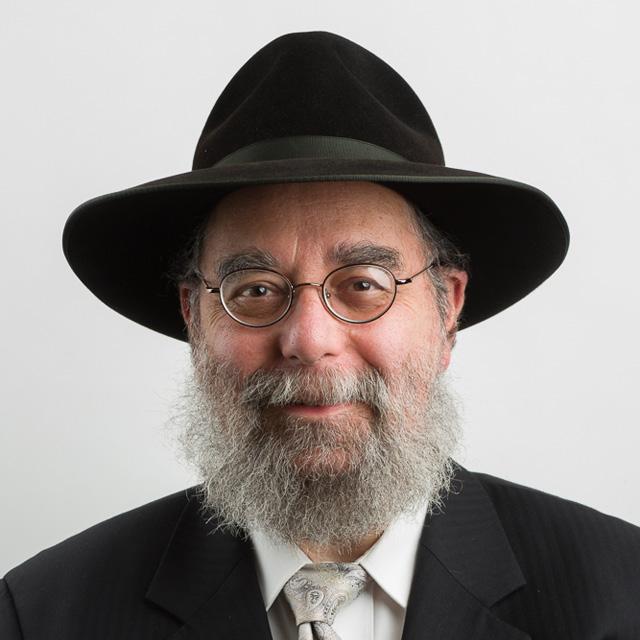
Rabbi Chaim Fogelman
Kashrus Vaad
“ R’ Eli is someone who takes the ma’amarei chazal of םינפ רבסב םדאה לכ
.עבק ךתרות השע תופי... as a mission statement to live by. His dedication to getting things done and in the most pleasant manner possible is remarkable and a great example for others.”
Rabbi Levi Marmulszteyn
Rabbinic Manager
~
MEET OUR STAFF:
BEHIND
20 www.OK.org
“
Eli Methal
רומא
תא לבקמ יוהו .הברה השעו טעמ
Frying Pans
By Rabbi Yakov Teichman, Rabbinic Coordinator
Someone taking a fleishig utensil and using it for milchig, or vice versa – sounds familiar? If you have been quarantined for long enough this is bound to happen. The actual halacha is beyond the scope of this article but this will provide an overview for one to better understand the actual question at hand. Can the frying pan be kashered? Does it make a difference if it’s from treif or from milchig to fleishig? What about from fleishig/ milchig to pareve? Can I have my favorite frying pan kashered for Pesach?
How is one supposed to kasher?
There are 3 basic levels of kashering that apply to frying pans:
Libun Gamur - heating the utensil until it is red hot (about 850°F)1
Libun Kal - heating the utensil to the degree that an easily combustible matter will singe when it touches the utensil (about 450°F)2
Hagalah - dipping the utensil into a pot of boiling water on the fire3
The method of kashering is dependent on the usage of the utensil - a grill which has direct fire (no medium between the food and grill) will require libun gamur, while hagalah will suffice for a pot used for soup. Libun Kal satisfies the requirements for hagalah and is also used in place of Libun Gamur in certain specific cases.
What about my frying pan?
Let’s explore what Chazal tell us about a frying pan. In Chazal, a frying pan is called a “machavas”, which is a shallow
frying pan that is typically used with the addition of a small amount of oil or fat to assist in the frying process. There is a dispute among the Poskim about which level of kashering is required. There are those that require libun gamur4, others that say that hagalah is sufficient5, and some differentiate between heteira bala (example chometz - when kashering for Pesach) and issura bala (non-kosher/ treif)6. Sephardim will rely on hagalah when kashering for Pesach, but will require libun gamur when kashering from treif7. Ashkenazim are stringent on Pesach to kasher with libun if possible, otherwise hagalah is sufficient8, and libun gamur is required when kashering from treif.
There are a few more points to consider when presenting the question to a Rav. There are some Poskim that consider that if the cooking medium is kosher, then hagalah is sufficient; if the oil or fat is not kosher, then libun is required9 Other Poskim say that sometimes the oil/fat gets burned or dried up in the frying process and then there is direct transfer of taste from the food to the pot which would require libun10.
Historically, frying pans were used together with oil or fat as a lubricant for the pan. The amount of oil used to qualify as a “machavas” is also a dispute but it definitely has to be enough to wet your hands and be able to transfer that wetness to another surface11. In
the 1960’s in the USA there were 2 important introductions to the consumer market – PAM cooking spray and Teflon non-stick pans. Both are widely used in the home kitchen and essentially eliminate the question of whether hagalah can be used as a kashering method. Using minimal oil (as with spray oils) is considered direct heat and requires libun gamur. In most situations, if one uses a non-stick pan without any spray or a regular frying pan with cooking spray, libun gamur would be the required method of kashering.
This leads us to another question. Libun gamur requires heating the pan to about 850°F. One of the fundamentals of kashering with libun gamur is that one must be certain that the utensil can withstand the process of libun gamur12 so that the libun is performed correctly. Teflon is a material that typically will get ruined in such intense heat and therefore libun gamur is not option according to most Poskim13. There is even a machlokes surrounding the validity of kashering a Teflon pot (not frying pan) via hagalah14, so Teflon pans are certainly a more challenging item to kasher.
As is evident from the complex details delineated above it is prudent for all household members who have access to the cooking utensils to have clear guidelines about which utensils are designated fleishig and which are designated milchig. Of course, mistakes can still happen, and if the situation arises at least we can be more knowledgeable on how to ask the question. ~
21 www.OK.org Kosher Kitchen your
1 ד”ס א”נת ’יס ח”וא ע”וש 2 םש א”מר 3 ג”ס םש ע”וש
4 ד”ש ד”ב ךוראה תיבה תרותב א”בשר 5 םש תיבה קדבב ה”אר 6 א”נת ’יס הכלה רואיבב אבוה א”בשרה םשב םחורי וניבר א”יס 7 ד”ס א”כק ’יס ד”ויו םש ע”וש 8 םש ח”ואב א”מר 9 ד”וי ס”תח ת”וש ןייעו ד”ס א”כק ’יס ד”וי א”קער תוהגה ’ז ק”ס םש ת”פב אבוה א”יק ’יס 10 ז”ט ק”ס א”נת ’יס ח”וא ז”בשמ ג”מפ 11 ו”ל ףיעס ברה ע”וש ןייעו ו”ע ק”ס א”נת ’יס םייחה ףכ
12 א”ס א”נת ’יס ע”וש 13 35 ’עה ח”פ ותכלהכ חספ רודיס בישילא ש”ירגה 14 ש”רגהו ץילרק נ”רגה תעד ןכו ,םש בישילא ש”ירגה ’ז ’יס ד”ח ז”עהא השמ תורגא ת”ושבו .םירסוא רנזאוו ןנברדמ קפס אוהד ןויכ י”בא םא ריתמ
www.KosherSpirit.com 21
CHASSIDIC INSIGHTS
Head and Beginning
There is nothing arbitrary about a name given in the Holy Tongue: the very letters that constitute such a name disclose the intrinsic nature of the entity named. The name of the New Year festival, “Rosh HaShanah,” literally means not “beginning of the year,” but “head of the year.” I.e., the relationship of Rosh HaShanah to the other days of the year parallels the relationship of the head to the other organs of the body.
There are three dimensions to the relationship between the head and the body. First, the brain controls the functioning of the body as a whole, as well as that of its individual organs. Second, the life-energy of all the organs is centered in the brain, each of whose components is connected to one of the organs. Finally, the brain is the seat of the power of thought, the highest of human faculties.
Chassidic Insights:
At One with the King
recognition establishes a bond between the essence of man and the essence of Gd.
Three Levels of Connection
Our divine service on Rosh HaShanah is characterized by spiritual parallels to each of these three physical functions.
First, on Rosh HaShanah we resolve to advance in all aspects of our Torah observance, and the resolutions undertaken at this time influence the quality of our divine service throughout the coming year.
Second, with Rosh HaShanah we begin the Ten Days of Teshuvah (usually translated “repentance”; better: “return”). Since teshuvah comprises all the other mitzvos, it can atone for deficiencies in the observance of any of the mitzvos
Finally, the divine service of Rosh HaShanah involves a level of absolute connection between man and Gd. Our Sages teach that on Rosh HaShanah Gd asks man to “accept Me as King over you,” and in fact the recognition of Gd’s sovereignty is a major theme of the Rosh HaShanah service. This act of
These three elements of Rosh HaShanah are related to three levels of connection with Gd.
(a) The first bond is established through Torah observance. Because Gd’s will is manifest in the Torah and its mitzvos, by observing them we connect our thoughts, words and actions with Him.

(b) There is, however, a second and deeper bond with Gd. For while it is true that observance of mitzvos establishes a connection with Gd, the conditions of this relationship presuppose that the individual is a separate entity who desires to connect to Gd through this observance. Teshuvah, by contrast, involves a bond which relates man to Gd directly, without the medium of mitzvos.
Each of us shares a bond with Gd that is not at all dependent on our deeds. For this reason, even a person who has failed to establish a connection with Gd through mitzvos or who
has obstructed that connection by his conduct, is still capable of feeling a desire to return to Him.
A person’s desire to return to Gd evokes a response from Him. Like a father who loves his children regardless of their conduct, Gd maintains a bond with us which continues even when our conduct appears to draw us away from Him. And when a person turns to Gd in teshuvah, this bond surfaces and makes its presence felt.
Since the connection to Gd established through teshuvah is deeper than that which is established through the observance of mitzvos, it can compensate for any deficiencies in our observance of the mitzvos Nothing can block the expression of this deep connection we share with Gd.
(c) Nevertheless, despite the depth of the connection with Gd established through teshuvah , a certain distance remains between man and Gd. In fact, it is our feeling of separation from Him that motivates our desire to return to Him. By contrast, our willingness to accept Gd as King expresses the idea of man’s absolute bond with Gd. Man accepts Gd’s sovereignty because he cannot conceive of any alternative; he cannot conceive of the possibility of living without a King.
(This understanding of the Kingsubject relationship also applies to Gd. Gd, so to speak, cannot conceive of being without subjects. It is for this reason that He turns to man and asks of him to “accept Me as King over you.”)
Adapted from Likkutei Sichos Vol. IV, Rosh HaShanah;Vol. XIX, Sukkos
The content in this page is produced by Chabad.org, and is copyrighted by the author and/or Chabad.org. If you enjoyed this article, we encourage you to distribute it further, provided that you do not revise any part of it, and you include this note, credit the author, and link to www.chabad.org. If you wish to republish this article in a periodical, book, or website, please email permissions@chabad.org.
22 www.OK.org
By Rabbi Chaim Fogelman
On Rosh Hashanah it’s decided how much money one will earn over the course of the entire year. The money spent on Talmud Torah (schar limud), Shabbos, Rosh Chodesh and Yom Tov is not included in this calculation.
The Gemara Rosh Hashanah relates that on Rosh Hashanah Hashem has three books – one for tzaddikim, one for reshaim, and one for beinonim (those who have both mitzvos and aveiros). Tzaddikim and reshaim are signed and sealed in their respective books immediately, but the book of the beinonim is not closed until Yom Kippur. The question that needs to be asked is, “Why have a separate book for beinonim at the end of Yom Kippur? Why not inscribe each one either in the book of tzaddikim or the book of reshaim?”
The answer is that those who do teshuvah are on an even higher level than a tzaddik, so they cannot be listed in the book of tzaddikim and need their own separate book.

ירשת
Rosh Hashanah is the first day of the month of Tishrei is an acronym for Talmud Torah, Shabbos, Rosh Chodesh and Yom Tov.
Sukkos is known as Z’man Simchaseinu (the Festival of Joy) because it shows Hashem’s love for the Jewish people. Sitting in the sukkah is akin to getting a hug from Hashem because one is surrounded from all sides by the sukkah. Sukkos has seven days. When you multiply the gematria of Ahava (13) by 7, it equals 91, which is the gematria of Sukkah
x 7 = 91
www.KosherSpirit.com 23
SOUL NUTRITION
הכוס
הבהא
2 cutting-edge Kosher apps... redesigned and reimagined.

”Kosher Investigator beautifully captures Rabbi Berel Levy’s remarkable contributions to kosher food – and, more generally, to Judaism. A skilled investigator himself, author Dovid Zakilowski draws on oral interviews, obscure printed sources, and Rabbi Levy’s previously unknown personal papers to provide a revelatory account of his life. Written with great sympathy – and not shying away from controversial topics – this carefully researched book is a page-turner that readers will thoroughly enjoy.”
—Dr. Roger Horowitz author of Kosher USA: How Coke became kosher and other tales of modern food.
The Kosher Vegetable Checking Guide
”Kosher Investigator pays honor to a founding father of modern industrial kosher certification. Rabbi Berel Levy’s passionate commitment to yiddishkeit and his keen powers of investigation helped transform the American kosher certification system into a model of reliable private regulation. Dovid Zaklikowski’s inspiring account also reveals the love of Torah and Am Yisroel that motivated Rabbi Levy’s many achievements.“
—Professor Timothy D. Lytton author of Kosher: Private Regulation in the Age of Industrial Food
For the latest in Kosher news:
follow us on Twitter
@KosherAlerts
follow us on Facebook facebook.com/okkosher
2 cutting-edge Kosher Apps, now redesigned and available as a free download on Google Play or the App Store

The Kosher Food and Restaurant Guide

KOSHER CERTIFICATION ~ Kosher Spirit, 391 Troy Avenue • Brooklyn, NY 11213 718-756-7500 • info@ok.org • www.ok.org
Coming Soon November 2017!

























